Crisis Communication Strategy in China
VerifiedAdded on 2020/05/28
|9
|2316
|145
AI Summary
This assignment delves into the complexities of crisis communication strategies within the Chinese context. It examines key factors like cultural differences, the role of social media, and the impact of uncertainty on public perception. The analysis uses case studies, including Foster Farms and KFC China, to illustrate best practices and potential pitfalls. The document emphasizes transparency, proactive communication, and understanding cultural sensitivities as crucial elements for successful crisis management in China.
Contribute Materials
Your contribution can guide someone’s learning journey. Share your
documents today.
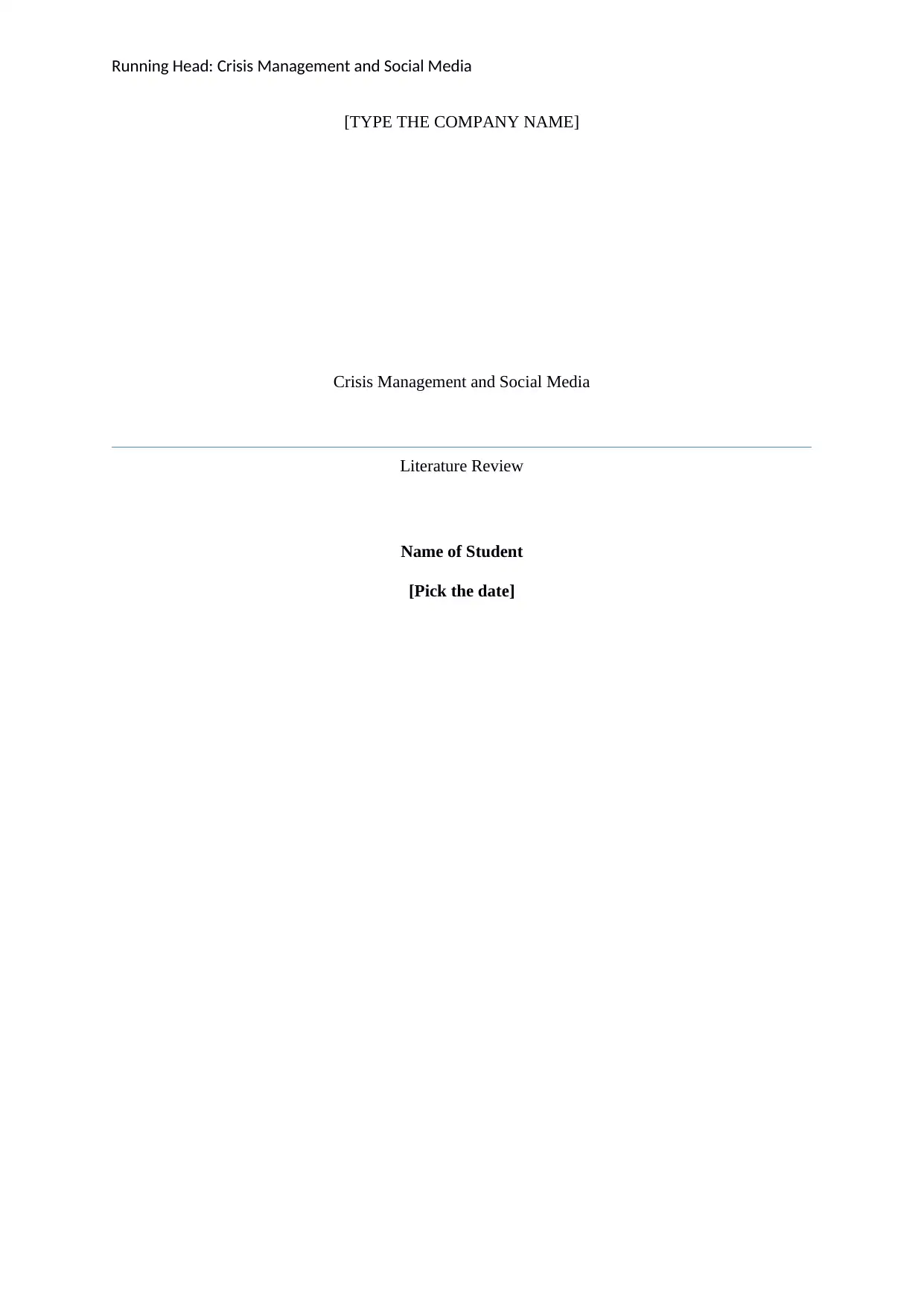
Running Head: Crisis Management and Social Media
[TYPE THE COMPANY NAME]
Crisis Management and Social Media
Literature Review
Name of Student
[Pick the date]
[TYPE THE COMPANY NAME]
Crisis Management and Social Media
Literature Review
Name of Student
[Pick the date]
Secure Best Marks with AI Grader
Need help grading? Try our AI Grader for instant feedback on your assignments.
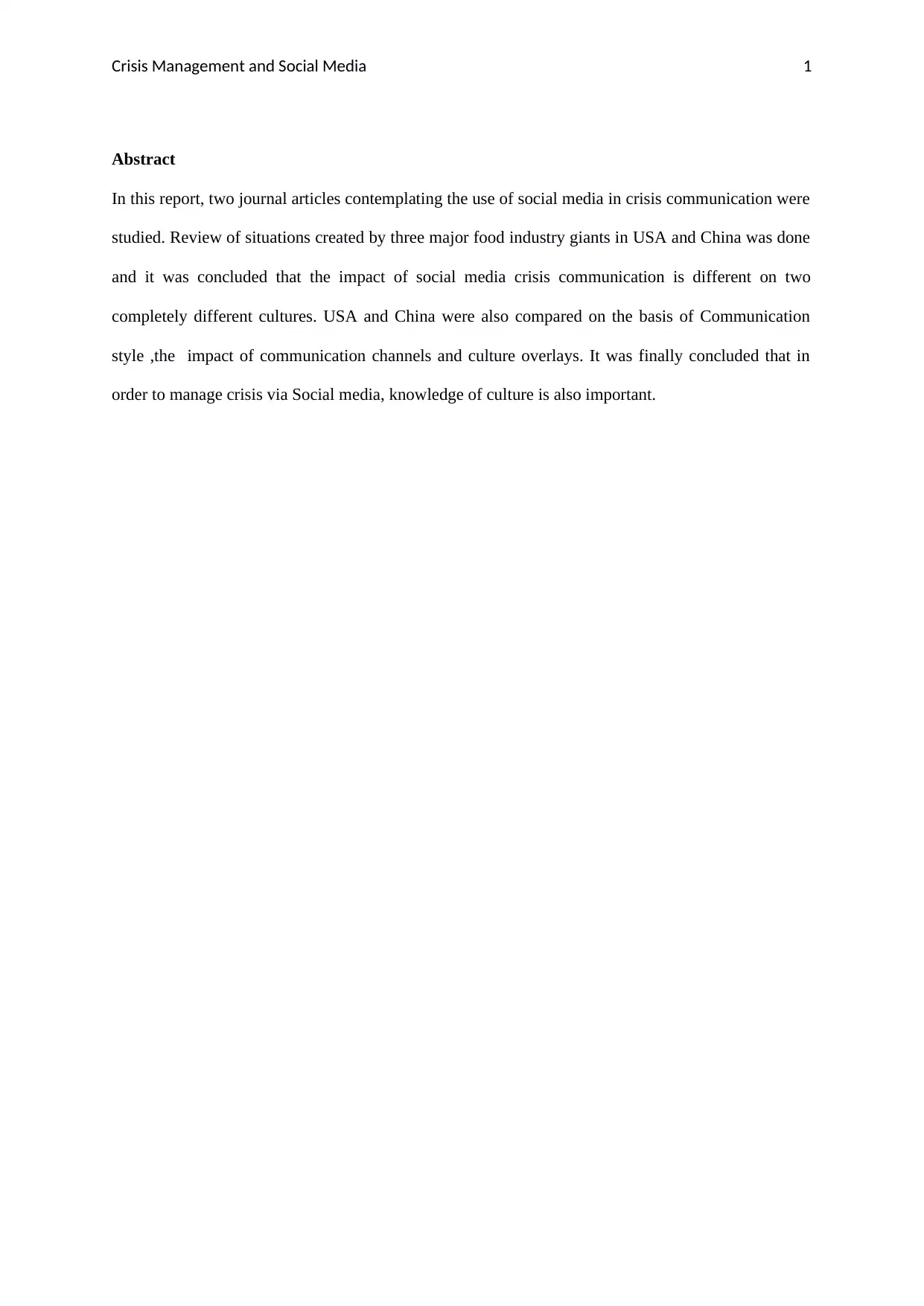
Crisis Management and Social Media 1
Abstract
In this report, two journal articles contemplating the use of social media in crisis communication were
studied. Review of situations created by three major food industry giants in USA and China was done
and it was concluded that the impact of social media crisis communication is different on two
completely different cultures. USA and China were also compared on the basis of Communication
style ,the impact of communication channels and culture overlays. It was finally concluded that in
order to manage crisis via Social media, knowledge of culture is also important.
Abstract
In this report, two journal articles contemplating the use of social media in crisis communication were
studied. Review of situations created by three major food industry giants in USA and China was done
and it was concluded that the impact of social media crisis communication is different on two
completely different cultures. USA and China were also compared on the basis of Communication
style ,the impact of communication channels and culture overlays. It was finally concluded that in
order to manage crisis via Social media, knowledge of culture is also important.
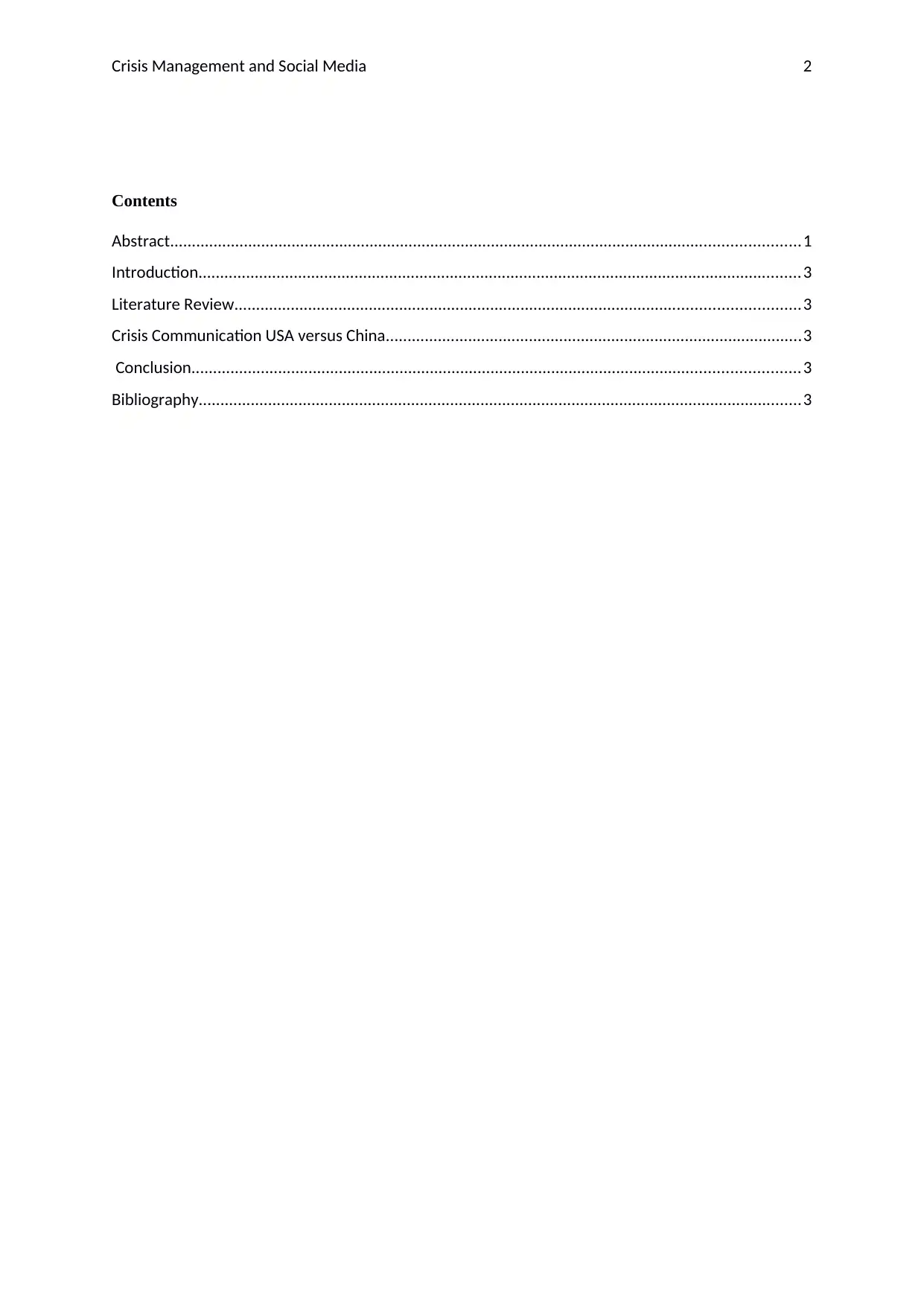
Crisis Management and Social Media 2
Contents
Abstract.................................................................................................................................................1
Introduction...........................................................................................................................................3
Literature Review..................................................................................................................................3
Crisis Communication USA versus China................................................................................................3
Conclusion............................................................................................................................................3
Bibliography...........................................................................................................................................3
Contents
Abstract.................................................................................................................................................1
Introduction...........................................................................................................................................3
Literature Review..................................................................................................................................3
Crisis Communication USA versus China................................................................................................3
Conclusion............................................................................................................................................3
Bibliography...........................................................................................................................................3
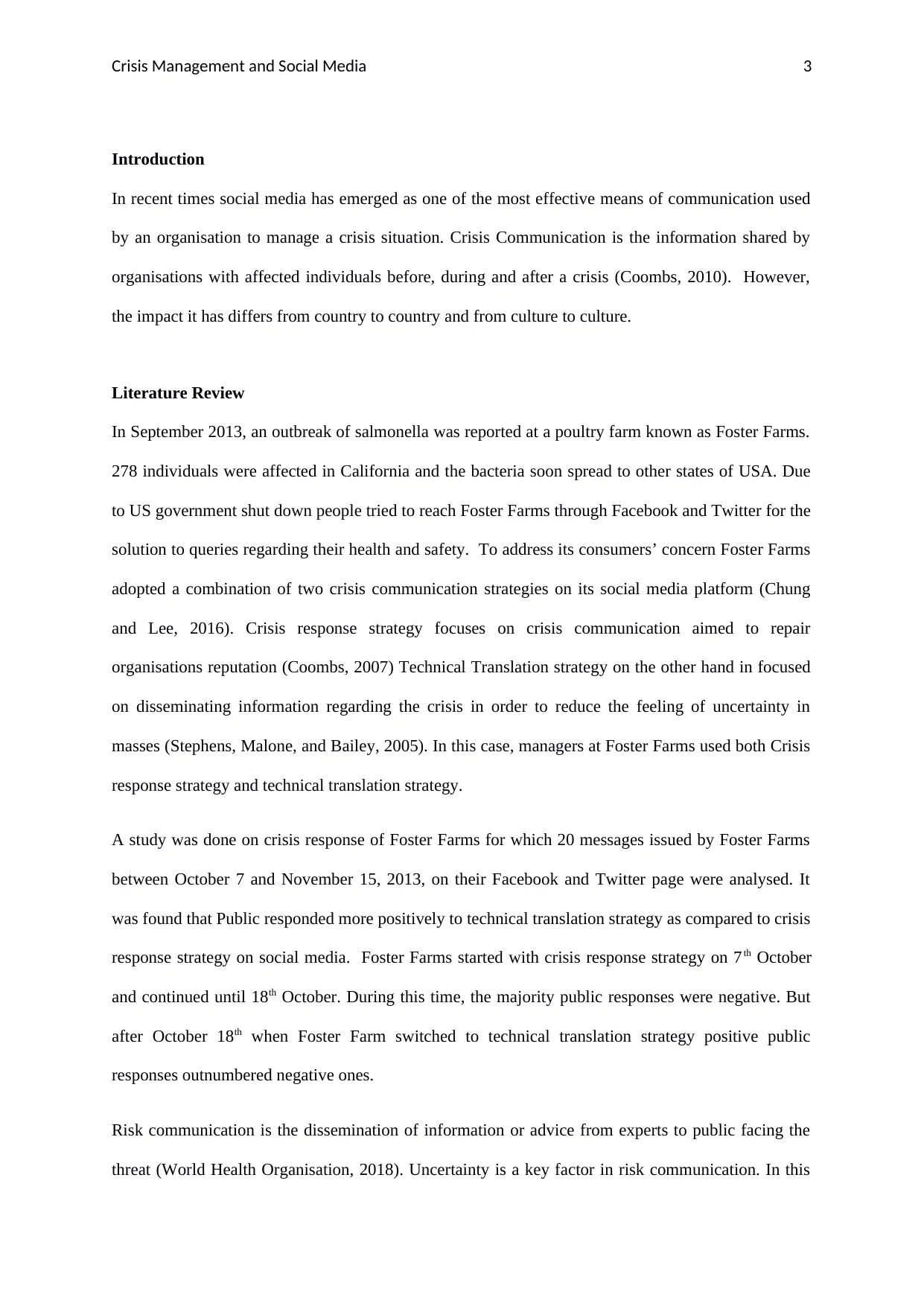
Crisis Management and Social Media 3
Introduction
In recent times social media has emerged as one of the most effective means of communication used
by an organisation to manage a crisis situation. Crisis Communication is the information shared by
organisations with affected individuals before, during and after a crisis (Coombs, 2010). However,
the impact it has differs from country to country and from culture to culture.
Literature Review
In September 2013, an outbreak of salmonella was reported at a poultry farm known as Foster Farms.
278 individuals were affected in California and the bacteria soon spread to other states of USA. Due
to US government shut down people tried to reach Foster Farms through Facebook and Twitter for the
solution to queries regarding their health and safety. To address its consumers’ concern Foster Farms
adopted a combination of two crisis communication strategies on its social media platform (Chung
and Lee, 2016). Crisis response strategy focuses on crisis communication aimed to repair
organisations reputation (Coombs, 2007) Technical Translation strategy on the other hand in focused
on disseminating information regarding the crisis in order to reduce the feeling of uncertainty in
masses (Stephens, Malone, and Bailey, 2005). In this case, managers at Foster Farms used both Crisis
response strategy and technical translation strategy.
A study was done on crisis response of Foster Farms for which 20 messages issued by Foster Farms
between October 7 and November 15, 2013, on their Facebook and Twitter page were analysed. It
was found that Public responded more positively to technical translation strategy as compared to crisis
response strategy on social media. Foster Farms started with crisis response strategy on 7th October
and continued until 18th October. During this time, the majority public responses were negative. But
after October 18th when Foster Farm switched to technical translation strategy positive public
responses outnumbered negative ones.
Risk communication is the dissemination of information or advice from experts to public facing the
threat (World Health Organisation, 2018). Uncertainty is a key factor in risk communication. In this
Introduction
In recent times social media has emerged as one of the most effective means of communication used
by an organisation to manage a crisis situation. Crisis Communication is the information shared by
organisations with affected individuals before, during and after a crisis (Coombs, 2010). However,
the impact it has differs from country to country and from culture to culture.
Literature Review
In September 2013, an outbreak of salmonella was reported at a poultry farm known as Foster Farms.
278 individuals were affected in California and the bacteria soon spread to other states of USA. Due
to US government shut down people tried to reach Foster Farms through Facebook and Twitter for the
solution to queries regarding their health and safety. To address its consumers’ concern Foster Farms
adopted a combination of two crisis communication strategies on its social media platform (Chung
and Lee, 2016). Crisis response strategy focuses on crisis communication aimed to repair
organisations reputation (Coombs, 2007) Technical Translation strategy on the other hand in focused
on disseminating information regarding the crisis in order to reduce the feeling of uncertainty in
masses (Stephens, Malone, and Bailey, 2005). In this case, managers at Foster Farms used both Crisis
response strategy and technical translation strategy.
A study was done on crisis response of Foster Farms for which 20 messages issued by Foster Farms
between October 7 and November 15, 2013, on their Facebook and Twitter page were analysed. It
was found that Public responded more positively to technical translation strategy as compared to crisis
response strategy on social media. Foster Farms started with crisis response strategy on 7th October
and continued until 18th October. During this time, the majority public responses were negative. But
after October 18th when Foster Farm switched to technical translation strategy positive public
responses outnumbered negative ones.
Risk communication is the dissemination of information or advice from experts to public facing the
threat (World Health Organisation, 2018). Uncertainty is a key factor in risk communication. In this
Secure Best Marks with AI Grader
Need help grading? Try our AI Grader for instant feedback on your assignments.
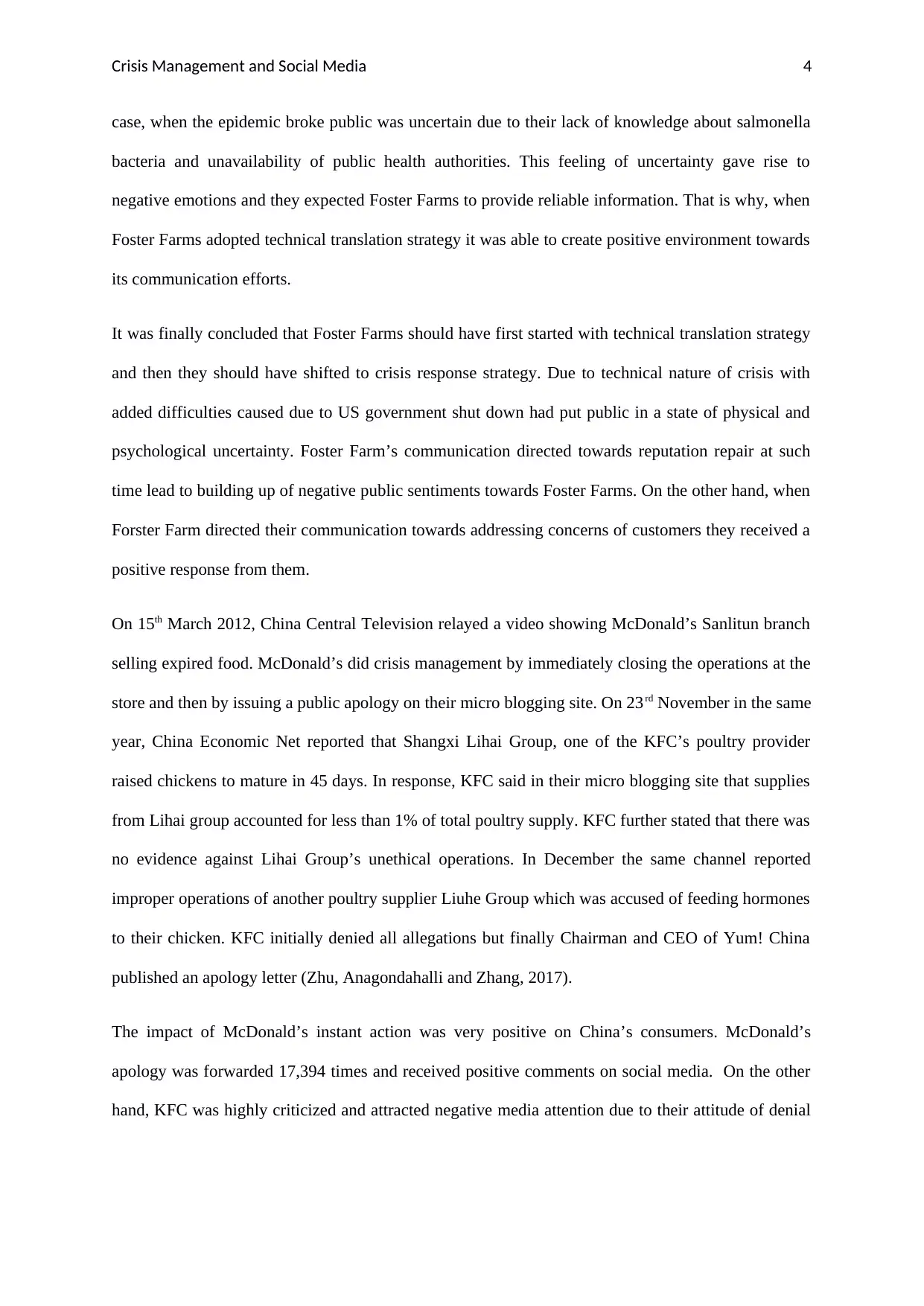
Crisis Management and Social Media 4
case, when the epidemic broke public was uncertain due to their lack of knowledge about salmonella
bacteria and unavailability of public health authorities. This feeling of uncertainty gave rise to
negative emotions and they expected Foster Farms to provide reliable information. That is why, when
Foster Farms adopted technical translation strategy it was able to create positive environment towards
its communication efforts.
It was finally concluded that Foster Farms should have first started with technical translation strategy
and then they should have shifted to crisis response strategy. Due to technical nature of crisis with
added difficulties caused due to US government shut down had put public in a state of physical and
psychological uncertainty. Foster Farm’s communication directed towards reputation repair at such
time lead to building up of negative public sentiments towards Foster Farms. On the other hand, when
Forster Farm directed their communication towards addressing concerns of customers they received a
positive response from them.
On 15th March 2012, China Central Television relayed a video showing McDonald’s Sanlitun branch
selling expired food. McDonald’s did crisis management by immediately closing the operations at the
store and then by issuing a public apology on their micro blogging site. On 23rd November in the same
year, China Economic Net reported that Shangxi Lihai Group, one of the KFC’s poultry provider
raised chickens to mature in 45 days. In response, KFC said in their micro blogging site that supplies
from Lihai group accounted for less than 1% of total poultry supply. KFC further stated that there was
no evidence against Lihai Group’s unethical operations. In December the same channel reported
improper operations of another poultry supplier Liuhe Group which was accused of feeding hormones
to their chicken. KFC initially denied all allegations but finally Chairman and CEO of Yum! China
published an apology letter (Zhu, Anagondahalli and Zhang, 2017).
The impact of McDonald’s instant action was very positive on China’s consumers. McDonald’s
apology was forwarded 17,394 times and received positive comments on social media. On the other
hand, KFC was highly criticized and attracted negative media attention due to their attitude of denial
case, when the epidemic broke public was uncertain due to their lack of knowledge about salmonella
bacteria and unavailability of public health authorities. This feeling of uncertainty gave rise to
negative emotions and they expected Foster Farms to provide reliable information. That is why, when
Foster Farms adopted technical translation strategy it was able to create positive environment towards
its communication efforts.
It was finally concluded that Foster Farms should have first started with technical translation strategy
and then they should have shifted to crisis response strategy. Due to technical nature of crisis with
added difficulties caused due to US government shut down had put public in a state of physical and
psychological uncertainty. Foster Farm’s communication directed towards reputation repair at such
time lead to building up of negative public sentiments towards Foster Farms. On the other hand, when
Forster Farm directed their communication towards addressing concerns of customers they received a
positive response from them.
On 15th March 2012, China Central Television relayed a video showing McDonald’s Sanlitun branch
selling expired food. McDonald’s did crisis management by immediately closing the operations at the
store and then by issuing a public apology on their micro blogging site. On 23rd November in the same
year, China Economic Net reported that Shangxi Lihai Group, one of the KFC’s poultry provider
raised chickens to mature in 45 days. In response, KFC said in their micro blogging site that supplies
from Lihai group accounted for less than 1% of total poultry supply. KFC further stated that there was
no evidence against Lihai Group’s unethical operations. In December the same channel reported
improper operations of another poultry supplier Liuhe Group which was accused of feeding hormones
to their chicken. KFC initially denied all allegations but finally Chairman and CEO of Yum! China
published an apology letter (Zhu, Anagondahalli and Zhang, 2017).
The impact of McDonald’s instant action was very positive on China’s consumers. McDonald’s
apology was forwarded 17,394 times and received positive comments on social media. On the other
hand, KFC was highly criticized and attracted negative media attention due to their attitude of denial
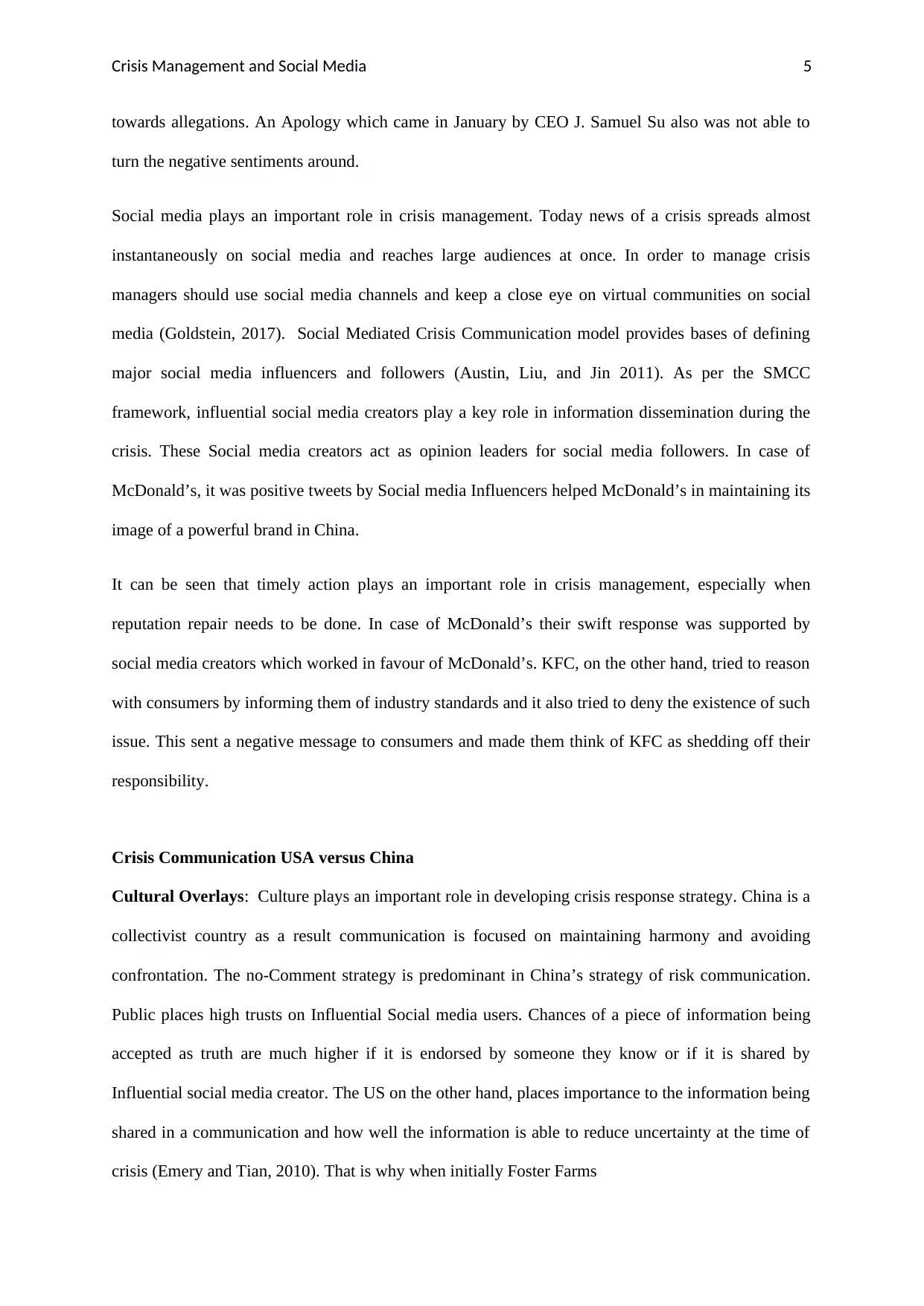
Crisis Management and Social Media 5
towards allegations. An Apology which came in January by CEO J. Samuel Su also was not able to
turn the negative sentiments around.
Social media plays an important role in crisis management. Today news of a crisis spreads almost
instantaneously on social media and reaches large audiences at once. In order to manage crisis
managers should use social media channels and keep a close eye on virtual communities on social
media (Goldstein, 2017). Social Mediated Crisis Communication model provides bases of defining
major social media influencers and followers (Austin, Liu, and Jin 2011). As per the SMCC
framework, influential social media creators play a key role in information dissemination during the
crisis. These Social media creators act as opinion leaders for social media followers. In case of
McDonald’s, it was positive tweets by Social media Influencers helped McDonald’s in maintaining its
image of a powerful brand in China.
It can be seen that timely action plays an important role in crisis management, especially when
reputation repair needs to be done. In case of McDonald’s their swift response was supported by
social media creators which worked in favour of McDonald’s. KFC, on the other hand, tried to reason
with consumers by informing them of industry standards and it also tried to deny the existence of such
issue. This sent a negative message to consumers and made them think of KFC as shedding off their
responsibility.
Crisis Communication USA versus China
Cultural Overlays: Culture plays an important role in developing crisis response strategy. China is a
collectivist country as a result communication is focused on maintaining harmony and avoiding
confrontation. The no-Comment strategy is predominant in China’s strategy of risk communication.
Public places high trusts on Influential Social media users. Chances of a piece of information being
accepted as truth are much higher if it is endorsed by someone they know or if it is shared by
Influential social media creator. The US on the other hand, places importance to the information being
shared in a communication and how well the information is able to reduce uncertainty at the time of
crisis (Emery and Tian, 2010). That is why when initially Foster Farms
towards allegations. An Apology which came in January by CEO J. Samuel Su also was not able to
turn the negative sentiments around.
Social media plays an important role in crisis management. Today news of a crisis spreads almost
instantaneously on social media and reaches large audiences at once. In order to manage crisis
managers should use social media channels and keep a close eye on virtual communities on social
media (Goldstein, 2017). Social Mediated Crisis Communication model provides bases of defining
major social media influencers and followers (Austin, Liu, and Jin 2011). As per the SMCC
framework, influential social media creators play a key role in information dissemination during the
crisis. These Social media creators act as opinion leaders for social media followers. In case of
McDonald’s, it was positive tweets by Social media Influencers helped McDonald’s in maintaining its
image of a powerful brand in China.
It can be seen that timely action plays an important role in crisis management, especially when
reputation repair needs to be done. In case of McDonald’s their swift response was supported by
social media creators which worked in favour of McDonald’s. KFC, on the other hand, tried to reason
with consumers by informing them of industry standards and it also tried to deny the existence of such
issue. This sent a negative message to consumers and made them think of KFC as shedding off their
responsibility.
Crisis Communication USA versus China
Cultural Overlays: Culture plays an important role in developing crisis response strategy. China is a
collectivist country as a result communication is focused on maintaining harmony and avoiding
confrontation. The no-Comment strategy is predominant in China’s strategy of risk communication.
Public places high trusts on Influential Social media users. Chances of a piece of information being
accepted as truth are much higher if it is endorsed by someone they know or if it is shared by
Influential social media creator. The US on the other hand, places importance to the information being
shared in a communication and how well the information is able to reduce uncertainty at the time of
crisis (Emery and Tian, 2010). That is why when initially Foster Farms
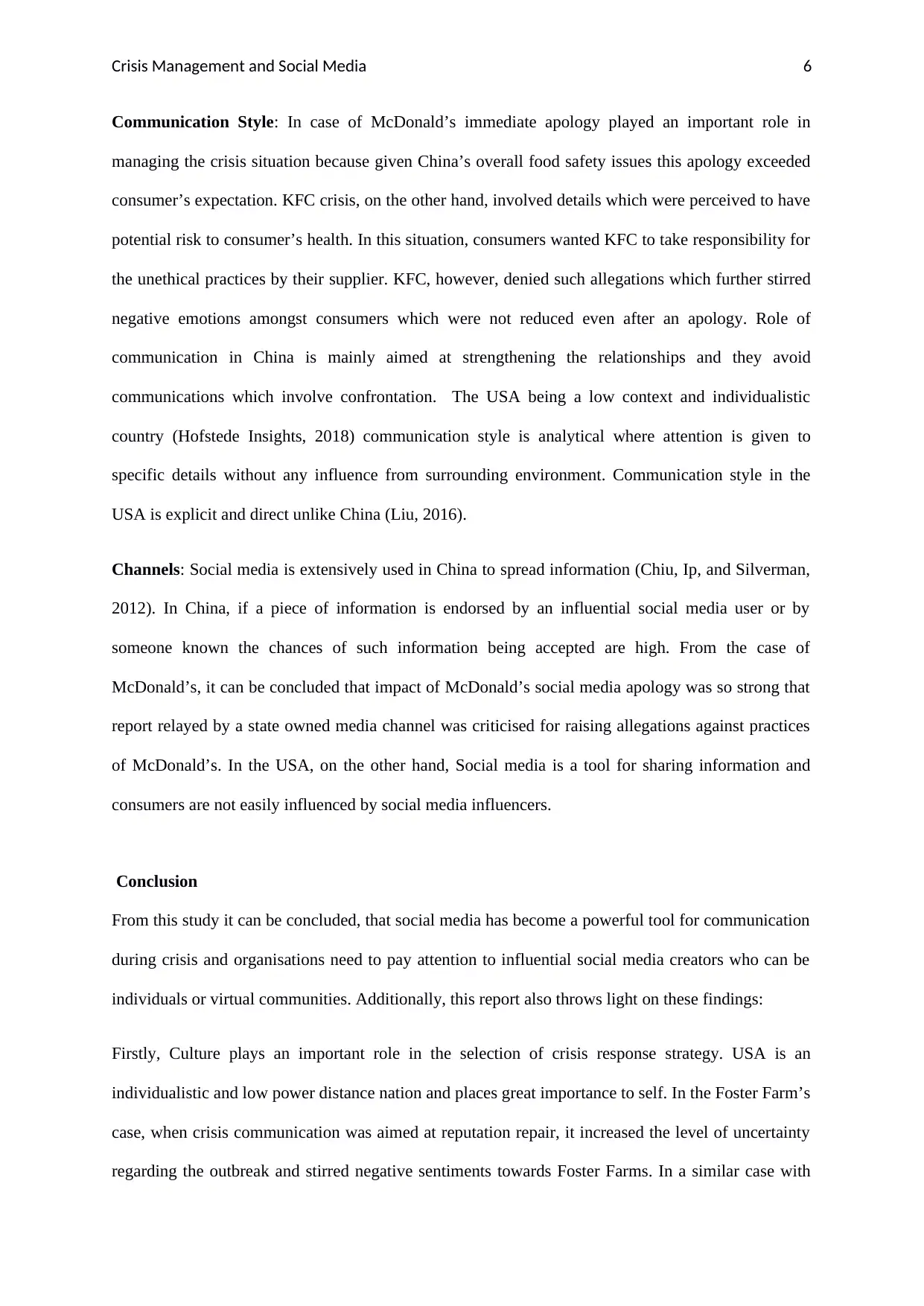
Crisis Management and Social Media 6
Communication Style: In case of McDonald’s immediate apology played an important role in
managing the crisis situation because given China’s overall food safety issues this apology exceeded
consumer’s expectation. KFC crisis, on the other hand, involved details which were perceived to have
potential risk to consumer’s health. In this situation, consumers wanted KFC to take responsibility for
the unethical practices by their supplier. KFC, however, denied such allegations which further stirred
negative emotions amongst consumers which were not reduced even after an apology. Role of
communication in China is mainly aimed at strengthening the relationships and they avoid
communications which involve confrontation. The USA being a low context and individualistic
country (Hofstede Insights, 2018) communication style is analytical where attention is given to
specific details without any influence from surrounding environment. Communication style in the
USA is explicit and direct unlike China (Liu, 2016).
Channels: Social media is extensively used in China to spread information (Chiu, Ip, and Silverman,
2012). In China, if a piece of information is endorsed by an influential social media user or by
someone known the chances of such information being accepted are high. From the case of
McDonald’s, it can be concluded that impact of McDonald’s social media apology was so strong that
report relayed by a state owned media channel was criticised for raising allegations against practices
of McDonald’s. In the USA, on the other hand, Social media is a tool for sharing information and
consumers are not easily influenced by social media influencers.
Conclusion
From this study it can be concluded, that social media has become a powerful tool for communication
during crisis and organisations need to pay attention to influential social media creators who can be
individuals or virtual communities. Additionally, this report also throws light on these findings:
Firstly, Culture plays an important role in the selection of crisis response strategy. USA is an
individualistic and low power distance nation and places great importance to self. In the Foster Farm’s
case, when crisis communication was aimed at reputation repair, it increased the level of uncertainty
regarding the outbreak and stirred negative sentiments towards Foster Farms. In a similar case with
Communication Style: In case of McDonald’s immediate apology played an important role in
managing the crisis situation because given China’s overall food safety issues this apology exceeded
consumer’s expectation. KFC crisis, on the other hand, involved details which were perceived to have
potential risk to consumer’s health. In this situation, consumers wanted KFC to take responsibility for
the unethical practices by their supplier. KFC, however, denied such allegations which further stirred
negative emotions amongst consumers which were not reduced even after an apology. Role of
communication in China is mainly aimed at strengthening the relationships and they avoid
communications which involve confrontation. The USA being a low context and individualistic
country (Hofstede Insights, 2018) communication style is analytical where attention is given to
specific details without any influence from surrounding environment. Communication style in the
USA is explicit and direct unlike China (Liu, 2016).
Channels: Social media is extensively used in China to spread information (Chiu, Ip, and Silverman,
2012). In China, if a piece of information is endorsed by an influential social media user or by
someone known the chances of such information being accepted are high. From the case of
McDonald’s, it can be concluded that impact of McDonald’s social media apology was so strong that
report relayed by a state owned media channel was criticised for raising allegations against practices
of McDonald’s. In the USA, on the other hand, Social media is a tool for sharing information and
consumers are not easily influenced by social media influencers.
Conclusion
From this study it can be concluded, that social media has become a powerful tool for communication
during crisis and organisations need to pay attention to influential social media creators who can be
individuals or virtual communities. Additionally, this report also throws light on these findings:
Firstly, Culture plays an important role in the selection of crisis response strategy. USA is an
individualistic and low power distance nation and places great importance to self. In the Foster Farm’s
case, when crisis communication was aimed at reputation repair, it increased the level of uncertainty
regarding the outbreak and stirred negative sentiments towards Foster Farms. In a similar case with
Paraphrase This Document
Need a fresh take? Get an instant paraphrase of this document with our AI Paraphraser
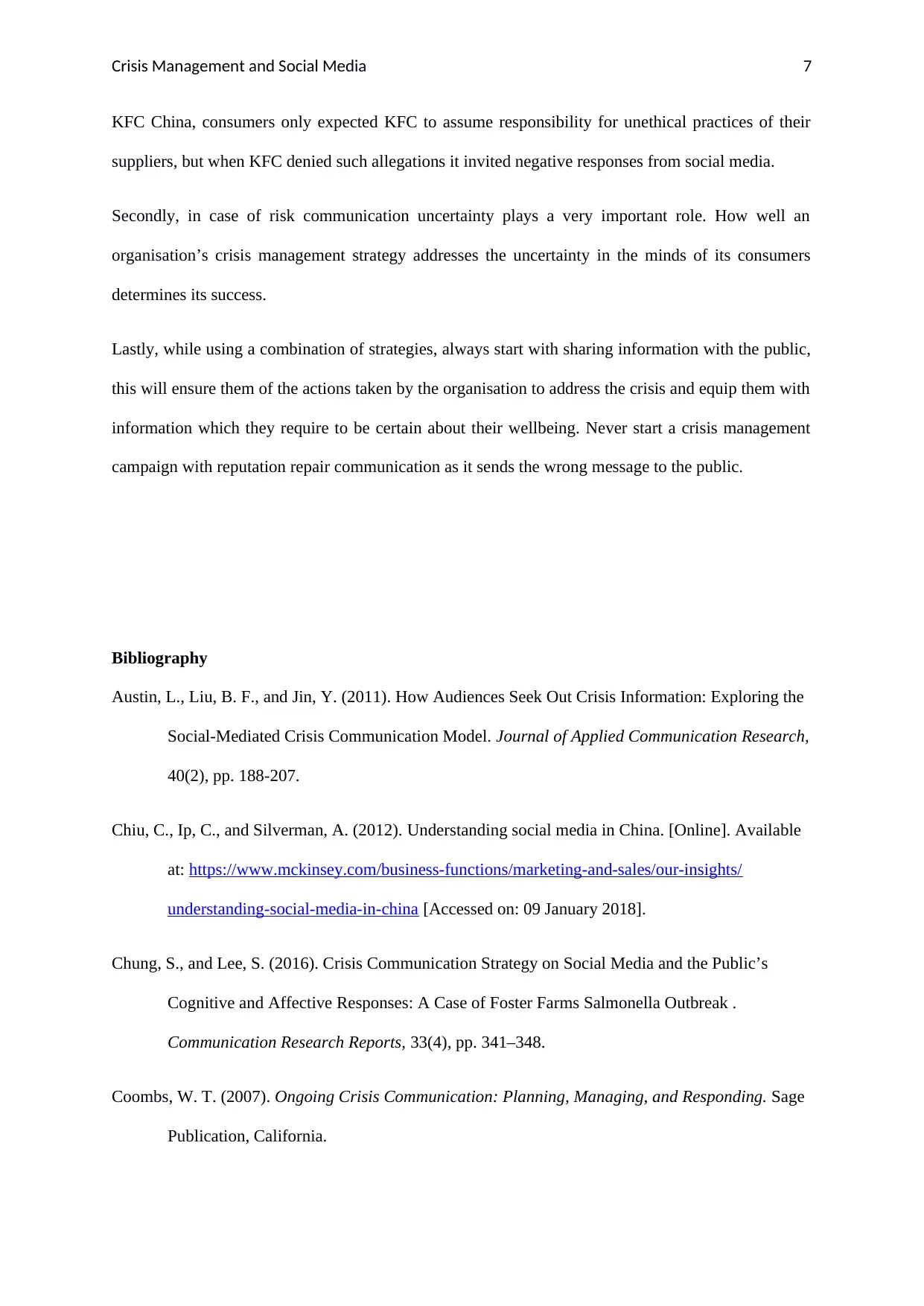
Crisis Management and Social Media 7
KFC China, consumers only expected KFC to assume responsibility for unethical practices of their
suppliers, but when KFC denied such allegations it invited negative responses from social media.
Secondly, in case of risk communication uncertainty plays a very important role. How well an
organisation’s crisis management strategy addresses the uncertainty in the minds of its consumers
determines its success.
Lastly, while using a combination of strategies, always start with sharing information with the public,
this will ensure them of the actions taken by the organisation to address the crisis and equip them with
information which they require to be certain about their wellbeing. Never start a crisis management
campaign with reputation repair communication as it sends the wrong message to the public.
Bibliography
Austin, L., Liu, B. F., and Jin, Y. (2011). How Audiences Seek Out Crisis Information: Exploring the
Social-Mediated Crisis Communication Model. Journal of Applied Communication Research,
40(2), pp. 188-207.
Chiu, C., Ip, C., and Silverman, A. (2012). Understanding social media in China. [Online]. Available
at: https://www.mckinsey.com/business-functions/marketing-and-sales/our-insights/
understanding-social-media-in-china [Accessed on: 09 January 2018].
Chung, S., and Lee, S. (2016). Crisis Communication Strategy on Social Media and the Public’s
Cognitive and Affective Responses: A Case of Foster Farms Salmonella Outbreak .
Communication Research Reports, 33(4), pp. 341–348.
Coombs, W. T. (2007). Ongoing Crisis Communication: Planning, Managing, and Responding. Sage
Publication, California.
KFC China, consumers only expected KFC to assume responsibility for unethical practices of their
suppliers, but when KFC denied such allegations it invited negative responses from social media.
Secondly, in case of risk communication uncertainty plays a very important role. How well an
organisation’s crisis management strategy addresses the uncertainty in the minds of its consumers
determines its success.
Lastly, while using a combination of strategies, always start with sharing information with the public,
this will ensure them of the actions taken by the organisation to address the crisis and equip them with
information which they require to be certain about their wellbeing. Never start a crisis management
campaign with reputation repair communication as it sends the wrong message to the public.
Bibliography
Austin, L., Liu, B. F., and Jin, Y. (2011). How Audiences Seek Out Crisis Information: Exploring the
Social-Mediated Crisis Communication Model. Journal of Applied Communication Research,
40(2), pp. 188-207.
Chiu, C., Ip, C., and Silverman, A. (2012). Understanding social media in China. [Online]. Available
at: https://www.mckinsey.com/business-functions/marketing-and-sales/our-insights/
understanding-social-media-in-china [Accessed on: 09 January 2018].
Chung, S., and Lee, S. (2016). Crisis Communication Strategy on Social Media and the Public’s
Cognitive and Affective Responses: A Case of Foster Farms Salmonella Outbreak .
Communication Research Reports, 33(4), pp. 341–348.
Coombs, W. T. (2007). Ongoing Crisis Communication: Planning, Managing, and Responding. Sage
Publication, California.
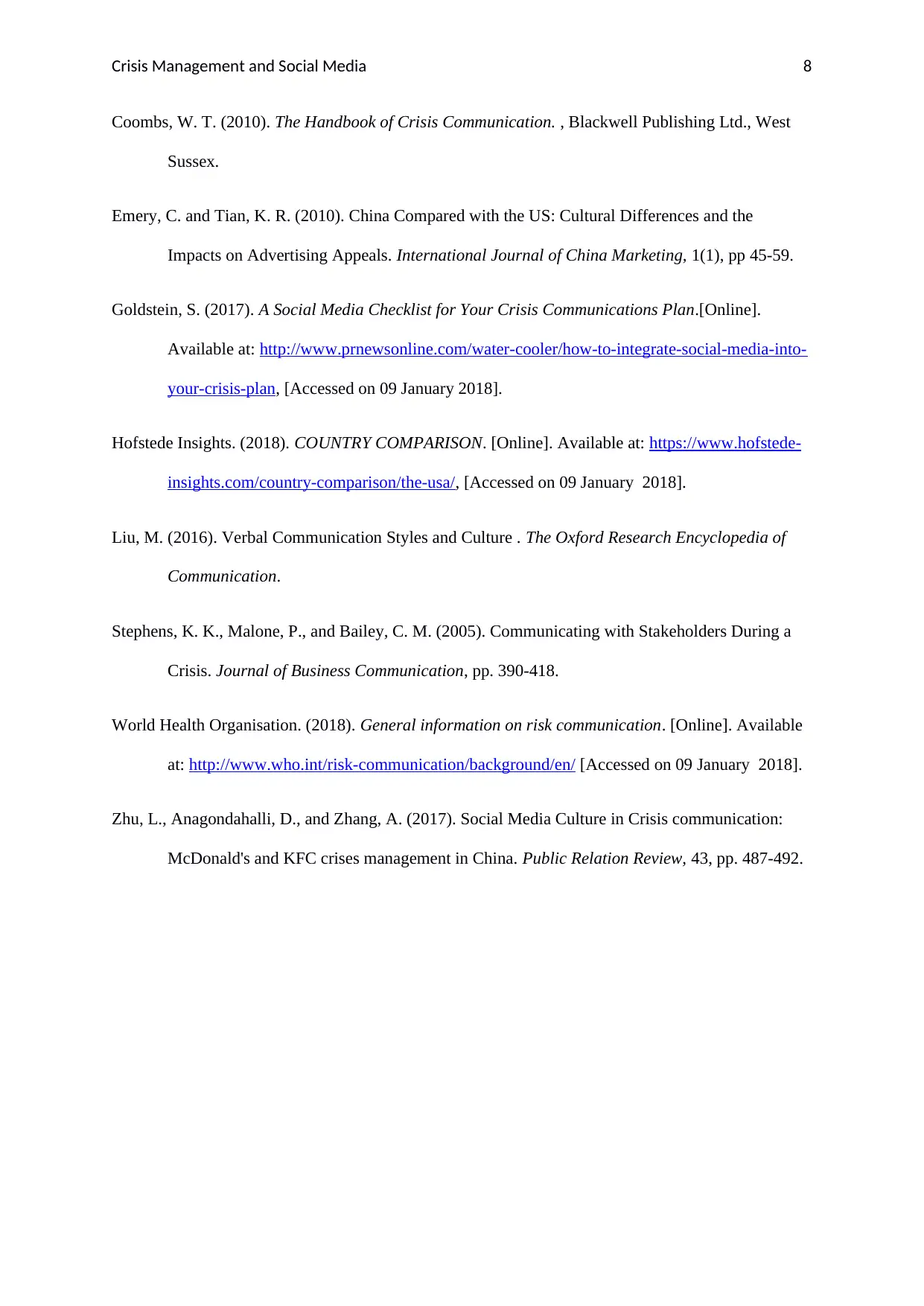
Crisis Management and Social Media 8
Coombs, W. T. (2010). The Handbook of Crisis Communication. , Blackwell Publishing Ltd., West
Sussex.
Emery, C. and Tian, K. R. (2010). China Compared with the US: Cultural Differences and the
Impacts on Advertising Appeals. International Journal of China Marketing, 1(1), pp 45-59.
Goldstein, S. (2017). A Social Media Checklist for Your Crisis Communications Plan.[Online].
Available at: http://www.prnewsonline.com/water-cooler/how-to-integrate-social-media-into-
your-crisis-plan, [Accessed on 09 January 2018].
Hofstede Insights. (2018). COUNTRY COMPARISON. [Online]. Available at: https://www.hofstede-
insights.com/country-comparison/the-usa/, [Accessed on 09 January 2018].
Liu, M. (2016). Verbal Communication Styles and Culture . The Oxford Research Encyclopedia of
Communication.
Stephens, K. K., Malone, P., and Bailey, C. M. (2005). Communicating with Stakeholders During a
Crisis. Journal of Business Communication, pp. 390-418.
World Health Organisation. (2018). General information on risk communication. [Online]. Available
at: http://www.who.int/risk-communication/background/en/ [Accessed on 09 January 2018].
Zhu, L., Anagondahalli, D., and Zhang, A. (2017). Social Media Culture in Crisis communication:
McDonald's and KFC crises management in China. Public Relation Review, 43, pp. 487-492.
Coombs, W. T. (2010). The Handbook of Crisis Communication. , Blackwell Publishing Ltd., West
Sussex.
Emery, C. and Tian, K. R. (2010). China Compared with the US: Cultural Differences and the
Impacts on Advertising Appeals. International Journal of China Marketing, 1(1), pp 45-59.
Goldstein, S. (2017). A Social Media Checklist for Your Crisis Communications Plan.[Online].
Available at: http://www.prnewsonline.com/water-cooler/how-to-integrate-social-media-into-
your-crisis-plan, [Accessed on 09 January 2018].
Hofstede Insights. (2018). COUNTRY COMPARISON. [Online]. Available at: https://www.hofstede-
insights.com/country-comparison/the-usa/, [Accessed on 09 January 2018].
Liu, M. (2016). Verbal Communication Styles and Culture . The Oxford Research Encyclopedia of
Communication.
Stephens, K. K., Malone, P., and Bailey, C. M. (2005). Communicating with Stakeholders During a
Crisis. Journal of Business Communication, pp. 390-418.
World Health Organisation. (2018). General information on risk communication. [Online]. Available
at: http://www.who.int/risk-communication/background/en/ [Accessed on 09 January 2018].
Zhu, L., Anagondahalli, D., and Zhang, A. (2017). Social Media Culture in Crisis communication:
McDonald's and KFC crises management in China. Public Relation Review, 43, pp. 487-492.
1 out of 9
Your All-in-One AI-Powered Toolkit for Academic Success.
+13062052269
info@desklib.com
Available 24*7 on WhatsApp / Email
![[object Object]](/_next/static/media/star-bottom.7253800d.svg)
Unlock your academic potential
© 2024 | Zucol Services PVT LTD | All rights reserved.


